Explore Kobe - Japan Travel, Asia
Kobe, a stunning city nestled between the coast and the mountains in Hyogo Prefecture, Japan, offers a unique blend of cultural heritage and modern attractions. Known for its scenic beauty, Kobe is a destination that captivates visitors with its charm and diverse experiences. Whether you're strolling through historical districts or enjoying the vibrant nightlife, Kobe promises an unforgettable journey. This guide provides an in-depth look at what makes Kobe a must-visit destination for travelers.
Seeking a tailored Japan adventure? Explore our premium Japan tour offerings here.
Population: Approximately 1.5 million in 2021.
Economy: House to the Port of Kobe-an important port and manufacturing center. Kobe surpasses Osaka to become the busiest port in the region, and the fourth busiest in Japan.
Landmarks: Kobe Harborland, Ikuta Shrine, and Arima Onsen.
Japan
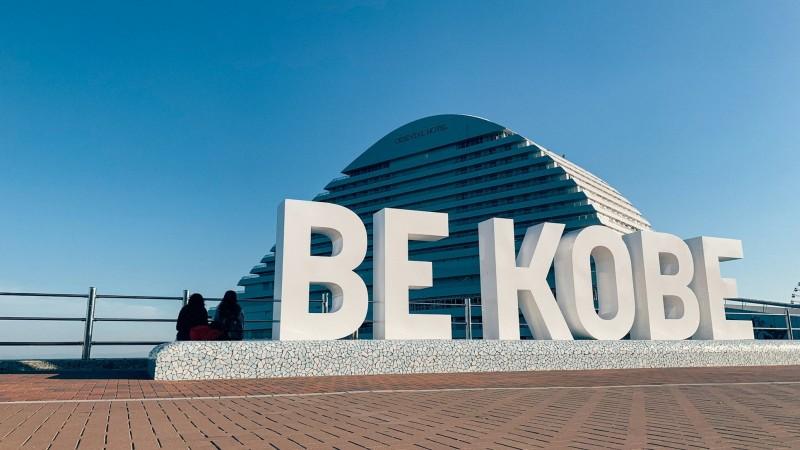
Overview of Kobe
History & Cultural Influence
Kobe's history dates back to the Nara period, and it has evolved into a vibrant port city with a rich cultural heritage. The city's strategic location as a port made it a key entry point for foreign trade, bringing Western influences that blend seamlessly with traditional Japanese culture. This unique fusion is evident in Kobe's architecture, cuisine, and cultural practices. One significant historical event is the Great Hanshin Earthquake of 1995, which profoundly impacted the city and its residents. The resilience and determination of Kobe's people have since transformed it into a symbol of recovery and innovation.
Interaction with The Locals
Kobe, Japan, is home to approximately 1.5 million residents, making it the sixth-largest city in Japan. The population is diverse, with a mix of locals and expatriates, contributing to the city’s vibrant culture. The residents of Kobe are known for their warmth and hospitality, making the interaction with the locals a rewarding experience, offering insights into the city’s soul. This blend of traditional Japanese lifestyle with international influences creates a unique and dynamic urban environment.
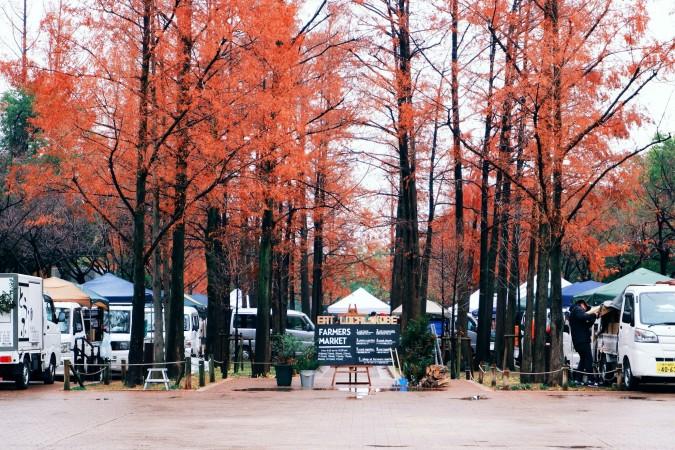
Farmer market in Kobe - © Suna Onne
Top Attractions in Kobe
Kobe, known for its vibrant port city atmosphere and rich cultural heritage, offers a variety of attractions that cater to diverse interests. From traditional Japanese gardens to Western-style structures, these must-see Kobe attractions provide a one-of-a-kind experience for any tourist seeking to see the seamless integration of East and West cultures.
- Kobe Harborland: This bustling waterfront area is a hub of entertainment, shopping, and dining. With its picturesque views of the harbor, it features the iconic Kobe Port Tower and the large Ferris wheel, providing stunning panoramic views of the city and harbor. The area is also home to a variety of restaurants, shops, and the popular Mosaic shopping complex.
- Kobe Nunobiki Herb Gardens: Located on the slopes of Mount Rokko, the Nunobiki Herb Gardens offer a serene escape with beautifully landscaped gardens featuring a wide variety of herbs and flowers. Visitors can enjoy guided tours, herb workshops, and scenic views of Kobe from the garden’s elevated locations, accessible via a charming cable car ride.
- Ikuta Shrine: This traditional Shinto temple, located in the city of Kobe, honors the goddess Wakahiru-me. Known for its beautiful traditional architecture and tranquil atmosphere, Ikuta Shrine is a significant cultural site and a popular spot for visitors seeking a peaceful retreat and a glimpse into Japan’s spiritual heritage.
- Arima Onsen: One of Japan’s oldest and most famous hot spring resorts, Arima Onsen is located just outside Kobe. Known for its therapeutic mineral waters, this onsen offers a relaxing experience with traditional ryokan accommodations and a range of public and private baths. It’s an ideal spot for unwinding and enjoying a fantastic Japanese hot spring experience.
- Mount Rokko: Mount Rokko, which offers amazing views of Kobe and the surrounding region, is a popular hiking, nature stroll, and panoramic viewing attraction. The mountain has several attractions, including the Rokko Garden Terrace, which offers breathtaking views, dining options, and shopping.
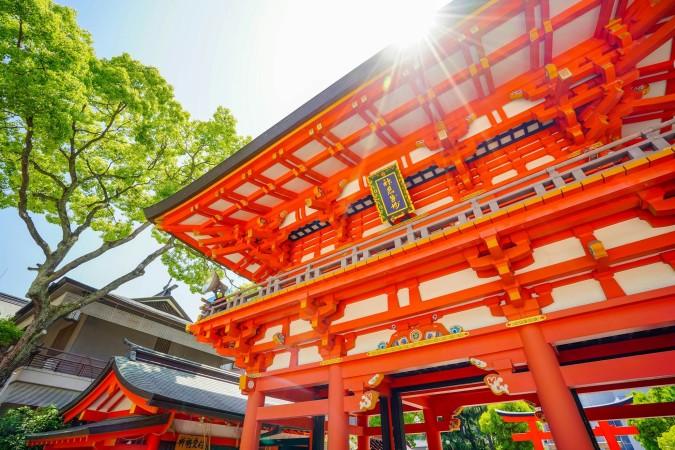
Ikuta Shrine - © ion C
Must-Try Dishes in Kobe
Kobe is renowned for its exceptional cuisine, blending traditional Japanese flavors with unique local specialties. Here’s a closer look at some must-try dishes that capture the essence of Kobe’s cuisine:
- Kobe Beef: Undoubtedly the star of Kobe’s culinary offerings, Kobe beef is world-famous for its rich marbling, tenderness, and deep flavor. This premium beef comes from the Wagyu breed of cattle raised in the Hyogo Prefecture. Enjoy it in various forms, such as grilled steaks, teppanyaki, or shabu-shabu (hot pot), and savor its melt-in-your-mouth texture and buttery taste.
- Sannomiya Ramen: A local favorite, Sannomiya ramen is known for its rich, savory broth and tender noodles. This dish typically features a pork-based or soy sauce-flavored broth, garnished with ingredients like sliced pork, green onions, and bamboo shoots. Each ramen shop in the Sannomiya area offers its unique twist on this comforting noodle soup.
- Kobe-style Teppanyaki: Teppanyaki is a style of cooking where ingredients are grilled on an iron plate right before your eyes. In Kobe, this often features high-quality Kobe beef alongside other ingredients like seafood, vegetables, and rice. The theatrical cooking style and fresh, flavorful ingredients make it a memorable dining experience.
- Kobe-style Okonomiyaki: This savory pancake is a popular Japanese dish made with a batter of flour, eggs, shredded cabbage, and a choice of meat or seafood. Kobe’s version often includes a special blend of ingredients and toppings, such as bonito flakes, pickled ginger, and a savory sauce, providing a unique and delicious taste.
- Kobe-style Takoyaki: These octopus-filled balls are a street food staple in Japan and are particularly popular in Kobe. Made from a batter of flour, eggs, and dashi (fish stock), takoyaki is typically filled with tender pieces of octopus and topped with savory sauces, bonito flakes, and green onions.
- Kobe Pudding: A delightful dessert, Kobe pudding is known for its smooth, creamy texture and rich vanilla flavor. This custard-style pudding is often served with a caramel sauce on top and is a sweet ending to any meal. It’s a local favorite that showcases Kobe’s talent for creating delicious sweets.
Looking for more adventures? Dive into Takamatsu, another famous destination in Japan, with our article here.
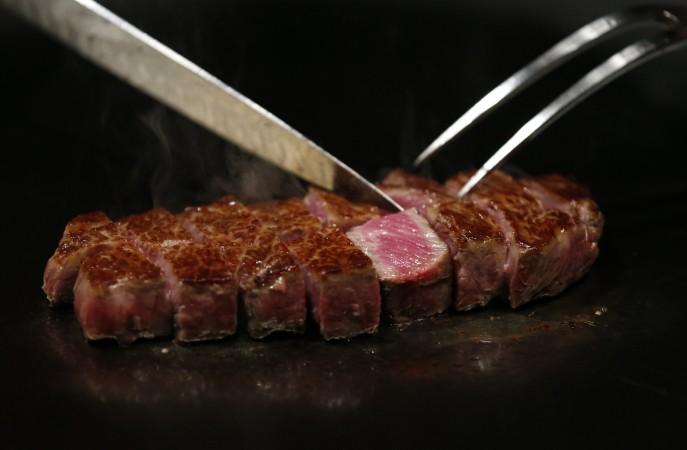
Famous Kobe Beef - © Newsweek
Festivals & Local Celebrations
Kobe is a city with a vibrant festival scene that reflects its diverse cultural influences and dynamic community spirit. Here’s a deeper look at some of the most notable festivals and local celebrations you can experience:
Kobe Luminarie
Held annually in December, the Kobe Luminarie is a spectacular light festival that commemorates the Great Hanshin Earthquake of 1995. The event features intricate light displays and illuminations that transform the city into a magical wonderland. It began as a tribute to those affected by the earthquake and has grown into a major event attracting visitors from around the world. Walking amid the sparkling lights is a moving and celebratory experience that embodies the spirit of perseverance and regeneration.
Kobe Festival
This lively festival takes place every May and celebrates the city’s rich cultural heritage with parades, street performances, and a variety of entertainment. The "Kobe Matsuri Parade," which includes colorful floats, traditional music, and dance performances, is the event's centerpiece. The festival also includes food stalls, craft booths, and cultural exhibits, providing a vibrant atmosphere where locals and visitors come together to enjoy Kobe’s cultural diversity.
Nada Fighting Festival (Nada no Kenka Matsuri)
Held in October at the Nada Shrine, this traditional festival is famous for its energetic and raucous atmosphere. The Nada Fighting Festival features a series of events, including the “Oniyo Matsuri,” where participants engage in mock battles with wooden sticks and throw stones at each other. This festival is a colorful and exhilarating display of local traditions and community spirit, offering visitors a chance to witness a unique and dynamic cultural experience.
Kobe Port Festival
The Kobe Port Festival, held in early May, commemorates the anniversary of Kobe Port's opening to international commerce. This event offers a variety of activities, such as marine parades, musical concerts, and fireworks displays. Visitors can enjoy boat rides, maritime exhibitions, and a variety of food stalls along the waterfront. The festival celebrates Kobe’s historical connection to the sea and its status as a global port city.
Arima Onsen Fireworks Festival
This event, held in August, takes place in the hot spring town of Arima Onsen, located just outside Kobe. The event features a stunning fireworks display over the hot spring town, offering a beautiful contrast between the night sky and the illuminated bursts of color. The festival is a popular summer event, drawing both locals and tourists who come to enjoy the fireworks and the relaxing atmosphere of the onsen town.
Kobe Jazz Street
Taking place in October, Kobe Jazz Street is a celebration of the city’s rich jazz heritage. Live jazz performances by local and international performers will take place in a variety of municipal locations. The festival showcases Kobe’s vibrant music scene and provides a platform for jazz enthusiasts to enjoy a diverse range of styles and performances in a lively and engaging setting.
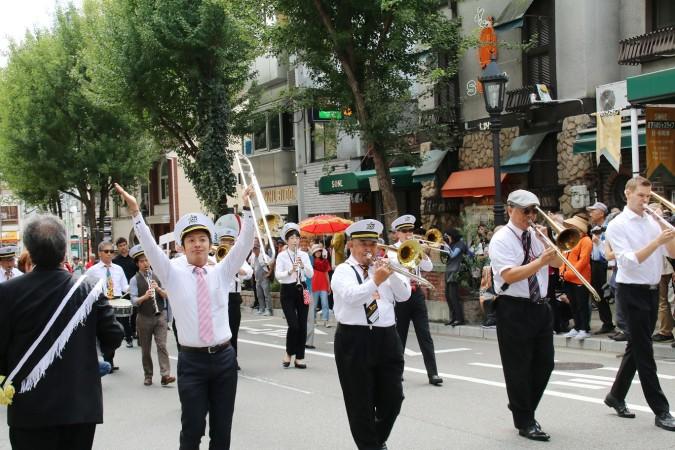
Kobe Jazz Street - © Kobe Jazz Street Official
What to Do in Kobe
Kobe offers a diverse range of tourist activities that cater to various interests, from outdoor adventures to cultural experiences. Here’s a detailed look at some of the top activities you can enjoy in this vibrant city:
- Exploring Kobe’s Waterfront: Visit the Kobe Harborland area for a scenic walk along the promenade, where you can enjoy the views of the harbor, shop at local boutiques, and dine at waterfront restaurants. The Kobe Port Tower, with its panoramic observation deck, provides stunning views of the city and harbor.
- Hiking Mount Rokko: For outdoor enthusiasts, hiking Mount Rokko offers a refreshing escape into nature. The mountain features several trails with varying difficulty levels, allowing hikers to enjoy lush forests, serene landscapes, and panoramic views of Kobe and the surrounding region. The Rokko Garden Terrace at the summit offers a relaxing spot to take in the scenery and enjoy a meal.
- Visiting Arima Onsen: A trip to the Arima Onsen hot spring town provides a quintessential Japanese experience. Enjoy soaking in the therapeutic mineral waters of the onsen, which are renowned for their healing properties. Many ryokan (traditional inns) in the area offer private baths, traditional meals, and a chance to relax in a tranquil setting.
- Exploring Kobe’s Chinatown (Nankinmachi): Kobe’s Chinatown is a vibrant area filled with bustling streets, colorful decorations, and a variety of Chinese eateries and shops. Wander through the lively streets, sample delicious street food like steamed buns and dumplings, and shop for unique souvenirs.
- Taking Harbor Cruises: Enjoy a leisurely harbor cruise to see Kobe from a different perspective. Various cruise options are available, from short scenic tours to longer excursions that include dining and entertainment. The cruises offer beautiful views of the city skyline, the waterfront, and the surrounding areas.
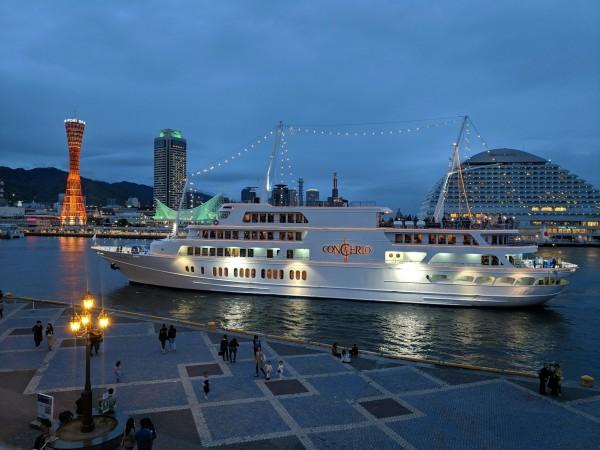
Harbor Cruises around Kobe's Port - © Andre Sayson
Shopping in Kobe
Kobe provides a broad and exciting shopping experience that appeals to a wide range of tastes and interests. Whether you’re looking for high-end fashion, unique local products, or traditional Japanese souvenirs, Kobe’s shopping options have something for everyone. Here’s a detailed look at what you can find:
Sannomiya District
The Sannomiya neighborhood, in the core of Kobe's shopping sector, is a hive of activity with a diverse selection of shopping alternatives. This area is home to numerous department stores, including high-end and mid-range retailers, where you can find everything from international brands to Japanese fashion. Popular shopping centers in Sannomiya include the Kobe Sanbangai and the Mosaic complex, which feature both large retail stores and smaller boutique shops.
Kobe Harborland
This waterfront shopping area blends shopping with scenic views. Harborland offers a mix of shopping malls, such as the umie Mosaic, where you can explore a variety of stores ranging from global fashion brands to local specialty shops. The area also has charming outdoor spaces, dining options, and entertainment facilities, making it a great destination for a leisurely shopping day.
Are you interested in Tokyo? Discover more about this unique destination with our article here.
Kobe Chinatown (Nankinmachi)
For a more vibrant and eclectic shopping experience, visit Kobe’s Chinatown. This bustling district is packed with shops selling Chinese goods, souvenirs, and street food. It’s an excellent place to find unique items like traditional Chinese herbs, handmade crafts, and specialty snacks. The lively atmosphere and colorful streets add to the charm of shopping in Nankinmachi.
Daimaru Kobe
One of Kobe’s major department stores, Daimaru offers a wide selection of high-end fashion, beauty products, and home goods. The store features several floors dedicated to different categories, including luxury brands, gourmet food, and lifestyle products. It’s an ideal place to find premium goods and enjoy a high-quality shopping experience.
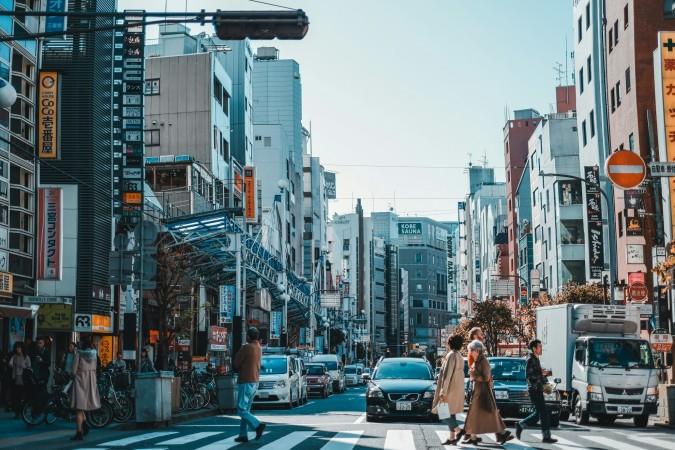
Walking along the street of Kobe - © Samantha Hendrata
Weather in Kobe: Best Time to Visit
Understanding Kobe's weather is essential for planning your visit, as it can greatly influence your travel experience. Discover the best time to visit Kobe with the overview of seasonal weather conditions and tourism trends.
Spring in Kobe
- Weather: Mild and pleasant temperatures range from 10°C to 20°C (50°F to 68°F). The season is known for its clear skies and fresh blooms.
- Tourism Trend: Spring is a popular time for tourists, especially during the cherry blossom season in late March to early April. The city's parks and gardens, such as Meriken Park and Sorakuen Garden, are filled with visitors enjoying the beautiful sakura.
Summer in Kobe
- Weather: Hot and humid, with temperatures often exceeding 30°C (86°F). Rain showers and thunderstorms are frequent.
- Tourism Trend: Despite the heat, summer attracts visitors to Kobe's beaches and waterfront areas. Festivals like the Kobe Fireworks Festival and the Kobe Port Marine Day draw large crowds. It’s also a great time for harbor cruises and enjoying the city's vibrant nightlife.
Autumn in Kobe
- Weather: Cool and comfortable, with temperatures ranging from 15°C to 25°C (59°F to 77°F). The season is marked by stunning autumn foliage.
- Tourism Trend: Autumn is a popular tourist season because of the stunning fall colors. Parks and mountains, such as Mount Rokko, become popular spots for hiking and nature walks. The pleasant weather also makes it ideal for exploring the city's historical sites and outdoor markets.
Winter in Kobe
- Weather: Mild winters with temperatures between 0°C and 10°C (32°F to 50°F). Snowfall is occasional but not heavy.
- Tourism Trend: Winter in Kobe is cozy and festive. The Kobe Luminarie light festival in December is a major draw, bringing visitors to the city to enjoy the illuminations. Hot springs (onsen) like Arima Onsen are popular for relaxation. Winter is also a great time to enjoy the city's culinary delights, such as hot pot dishes.
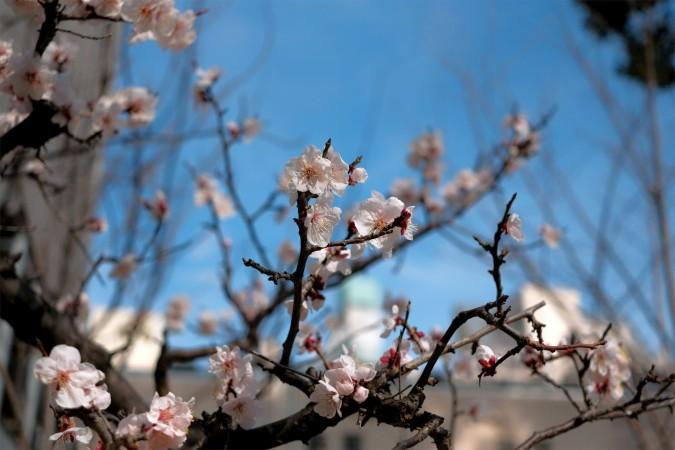
Cherry blossom season in Kobe - © WL ST
Culture Etiquette in Kobe
When visiting Kobe, it’s essential to understand and respect the unique cultural etiquette that reflects both traditional Japanese customs and the city’s distinct local flavor.
Dining Out in Kobe
- Kobe Beef Etiquette: When enjoying the world-renowned Kobe beef, it’s customary to savor it slowly and appreciate its quality. Chefs often prepare it right in front of you at teppanyaki restaurants, so showing respect and gratitude for their skill is important.
- Sake Appreciation: Kobe is well-known for its sake brewers in the Nada neighborhood. When drinking sake, always pour for others before filling your own cup, and hold your cup with both hands when someone pours for you as a sign of respect.
Shopping and Tipping
- No Tipping: Tipping is not customary in Kobe or Japan in general. Excellent service is the standard, and tipping can be seen as unnecessary or even rude.
- Customer Service: Expect exceptional customer service in shops and restaurants. Politeness, attentiveness, and efficiency are a must in the service industry in Kobe. Showing appreciation through verbal thanks is usually sufficient.
Public Spaces and Cleanliness
- Trash Disposal: At festival venues, there are designated areas for trash. It’s considered polite and necessary to dispose of your waste properly and keep the environment clean.
- Smoking: Smoking is restricted in many public areas. Look for designated smoking zones and avoid smoking while walking or in non-smoking areas.
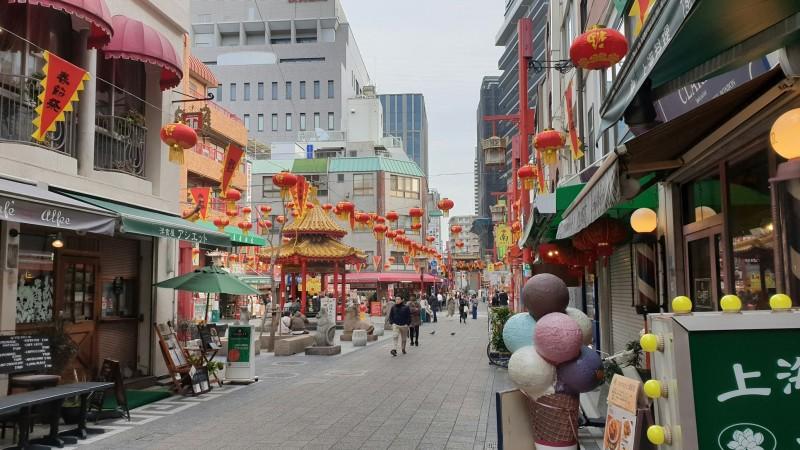
Chinatown in Kobe - © Kevin Pierson
Essential Travel Information
Getting Around Kobe
Getting around Kobe is convenient, with a variety of transportation options available. The JR Kobe Line railways connect the city to major destinations like Osaka and Kyoto, while the Shinkansen (bullet train) stops at Shin-Kobe Station for rapid travel. Kobe’s bus network covers areas not accessible by train and offers easy access to major attractions. Additionally, Kobe’s port provides ferry services to nearby islands and other parts of Japan, facilitating regional exploration. Taxis are widely available, however, more expensive, and ride-sharing services like Uber are also an option, though less common than in other countries.
ATM & Banking Services
Visitors to Kobe will find a range of convenient banking services to manage their finances. ATMs are widely available in convenience stores, banks, and shopping centers, and many accept international cards, though checking for compatibility is recommended. Currency exchange services can be found at major banks, the airport, and some hotels, with varying rates, so comparing options is advisable.
Where to Stay in Kobe
Kobe offers a wide range of accommodation options to suit various preferences and budgets. For those seeking luxury, there are high-end hotels providing premium services, stunning views, and lavish amenities. Mid-range hotels offer a balance of comfort and convenience at a more affordable price. Budget-conscious travelers can find economical yet comfortable options, while traditional inns, or ryokan, offer an authentic Japanese experience with hot springs and traditional meals.
Articles for you

Experience Aboard The RV Indochine II - A Mekong Cruise With Tweet World Travel
The RV Indochine II is a luxury river cruise ship, offering an unforgettable journey through many attractions along the Mekong River. Built in 2017, this upscale vessel combines colonial elegance with modern conveniences to create a comfortable yet stylish environment for its crew and passengers. The ship’s intimate size makes it ideal for those seeking a more personal cruising experience while exploring Vietnam and Cambodia rich culture, scenery, and heritage. Whether you're gazing at the landscape from your private balcony or enjoying authentic local cuisine, RV Indochine II promises an exotic adventure like no other.

Witness Stilt Fishing In Sri Lanka: An Eco-Tourism Experience
Sri Lanka, renowned for its stunning beaches and rich cultural heritage, harbors a unique tradition that has captivated travelers for centuries: stilt fishing. This ancient practice, passed down through generations of coastal communities, blends artistry with necessity, offering a glimpse into a way of life intimately connected to the island's coastal rhythms. Stilt fishing in Sri Lanka isn't merely a means to catch fish; it's a cultural emblem, embodying the resilience and ingenuity of Sri Lanka's fishing communities.

Make Your Trip Stress-Free With The Tweet Trip App
Embark on your next adventure with confidence by downloading the Tweet Trip App, available for both iOS and Android. This essential travel companion allows you to view your detailed itinerary, stay connected with your tour guide and fellow travelers, receive real-time updates, and provide feedback effortlessly. With features like in-app messaging, emergency assistance, and location sharing, the Tweet Trip App ensures you travel smarter, stay connected, and enjoy a seamless, worry-free journey. Get started today and make the most of your travel experience with Tweet World Travel.

Pedal Through Paradise: Unveiling Cambodia's Hidden Gems on Two Wheels
The gentle whir of bicycle wheels mingles with the distant chants of monks as you glide past emerald rice paddies stretching to the horizon. This is Cambodia - a sensory explosion waiting to be experienced on two wheels. At Tweet Tours, we believe there's no better way to immerse yourself in the Kingdom of Wonder than by bicycle.
Cambodia isn't just a destination; it's a living, breathing tapestry of ancient wonders, natural beauty, and vibrant culture. Our carefully crafted cycling tours take you beyond the typical tourist haunts, offering a unique perspective on this captivating country. Ready to clip in and discover the magic of Cambodia? Let's ride!

Trekking in the Himalayas: A Journey Through Nepal's Majestic Peaks
The Himalayas rise from the earth like colossal guardians, their snow-capped peaks piercing the sky in a display of nature's raw power and beauty. Nepal, nestled at the heart of this mountain range, serves as the gateway to some of the most breathtaking trekking experiences on the planet. Here, the air is crisp and thin, filled with the promise of adventure and the whispers of ancient tales.
With Tweet Tours, as you set foot on these hallowed trails, you're not just a traveler - you're a modern-day explorer, following in the footsteps of legendary mountaineers and age-old traders. Each step takes you further into a world where nature reigns supreme and human resilience is tested against the backdrop of some of the world's highest peaks.
From the moment your boots touch the ground in Kathmandu, you'll feel the pull of the mountains. The bustling streets of the capital, with their sensory overload of sights, sounds, and smells, soon give way to serene mountain paths where the only soundtrack is the crunch of gravel underfoot and the distant tinkling of yak bells.

Exploring Mui Ne's Wonders: Unique Attractions & Local Dishes
Nestled along the southeastern coast of Vietnam, Mui Ne emerges as a captivating gem, blending natural wonders with cultural richness. Renowned for its stunning landscapes and unique attractions, Mui Ne beckons travelers seeking both relaxation and adventure in equal measure. Mui Ne's renowned beach dunes, bustling fishing towns, and excellent local food await exploration at every turn.
The allure of Mui Ne lies not only in its pristine beaches and crystal-clear waters but also in its diverse range of activities catering to every traveler's whims. Whether you're drawn to thrilling water sports like kitesurfing and windsurfing on its dynamic shores or seeking tranquility amidst the picturesque Fairy Stream, Mui Ne promises an unforgettable journey filled with discovery.
